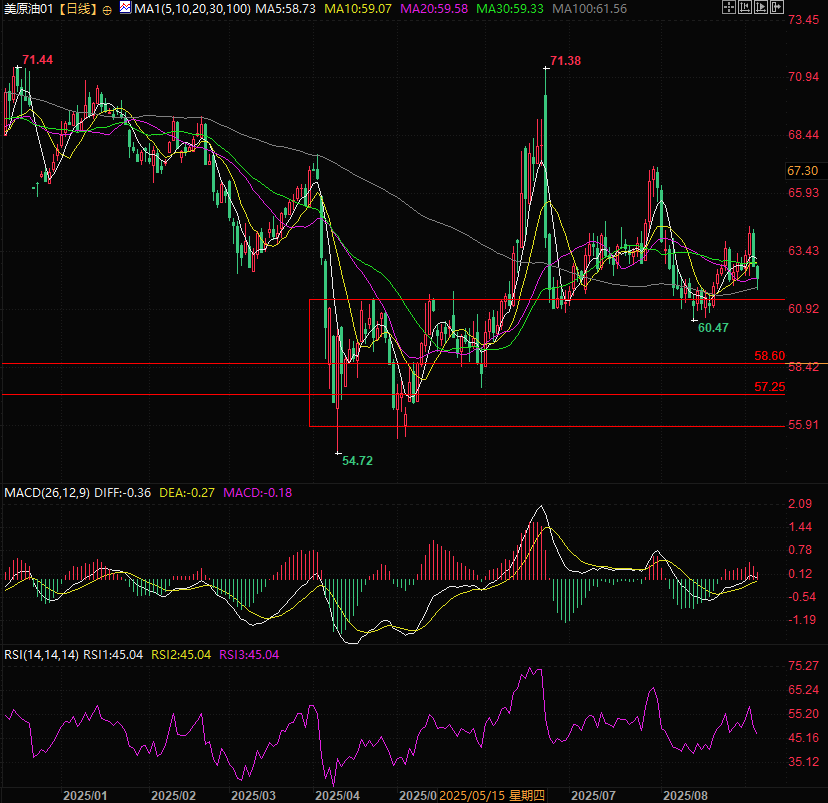Oversupply and geopolitical tensions intertwine, and the international crude oil market faces repricing.
2025-11-25 19:30:46
Recently, oil prices have experienced a resistant decline. The resistance comes from two factors: the strengthening of the stock market and the pressure on oil prices from the expectation of the resumption of peace talks between Russia and Ukraine and the unaffected supply.

The Russia-Ukraine peace talks will impact oil price and supply expectations.
The United States and Ukraine held talks in Geneva on Sunday, with both sides calling the talks "productive" and agreeing to continue intensive consultations on a "refined" peace plan proposed by the United States.
The market generally believes that if peace is achieved in Ukraine, some restrictions and limitations on Russia may be eased, which will further put downward pressure on energy prices. However, in the short term, marginal changes in geopolitical risk premiums are prompting traders to repric.
However, Ukrainian officials revealed that the new peace plan contains 19 articles and does not set any hard constraints on the size of the Ukrainian military. Judging from the probability of the agreement being implemented, Russia's acceptance of the above-mentioned articles is questionable, and geopolitical negotiations remain deadlocked.
Yesterday's rise in oil prices may have been a gamble on the prospects of signing the 28 contracts originally proposed by the United States.
US President Donald Trump also posted on his social media platform that "there may be positive developments happening." The market is focusing on these developments, and traders, while following the strength of risk assets, are still waiting for further clear signals.
Arne Roman Rasmussen, chief analyst at Global Risk Management, pointed out that the oil market is likely to remain tense before Thanksgiving this Thursday, and the probability of a peace agreement or ceasefire agreement being reached over the weekend is rising, which may support further declines in oil prices.
Dennis Kisler, Senior Vice President of Trading at BOK Financial, predicts that the market will remain volatile before the holiday, and there may be a short-covering rally.
It is worth noting that US crude oil futures are on track for their fourth consecutive month of decline, which would be the longest losing streak since 2023.
Trade pattern adjustment: Restrictions on Russia have not significantly affected crude oil supply
Another important variable on the supply side is the restructuring of global crude oil trade flows following the escalation of restrictions on Russia.
Following the U.S. imposing restrictions on Russia's leading energy producers Rosneft PJSC and Lukoil PJSC, this latest set of restrictions is a further escalation of previous restrictions on GazpromNeft PJSC and Surgutneftegas PJSC. As a result, Indian refineries have significantly increased their crude oil purchases from the Middle East and other regions.
However, the actual impact on crude oil supply has gone against market expectations. Due to the low-price strategy of Russia's core crude oil variety "Urals", Indian refineries have softened their stance.
According to sources, Indian refineries are currently offering Ural crude oil at a discount of up to $7 per barrel to Dated Brent crude oil, the lowest level in at least two years, based on landed prices. These offers correspond to crude oil tankers that will load in December and arrive in January 2025.
In other words, the supply of crude oil was not significantly restricted before and after the restrictions; it was just that India bought it at a lower price, and Russia earned less.
It is worth noting that only about one-fifth of all the crude oil tankers currently quoting prices come from entities not on the restricted blacklist. This means that despite the attractive prices, the risk of non-compliance restrictions still limits the potential for recovery in Russian-Indian crude oil trade.
Key institutional forecast: Oversupply will dominate the long-term downward trend.
JPMorgan Chase's latest forecast indicates that Brent crude oil prices, the international benchmark, could fall to the $30 per barrel range by 2027 due to a severe oversupply in the global oil market. The core support for this pessimistic outlook is market concerns about continued supply expansion – the International Energy Agency has warned of a record oil supply glut in 2026.
Goldman Sachs offers a more specific short- to medium-term outlook: In 2026, the average daily oversupply of West Texas Intermediate (WTI) crude oil will reach 2 million barrels, with the average annual price potentially only $53 per barrel. Darn Struvin, co-head of global commodities research at the bank, explicitly stated that oil prices will continue their downward trend next year and advised investors to decisively establish short positions in crude oil now.
However, Goldman Sachs also pointed out that 2026 will be the final year of the current massive supply surge impacting the market, and the oil market is expected to complete its rebalancing in 2027.
Despite the collective bearish outlook from institutions, there is still a consensus in the market that there is support for the current phase: analysts and investment banks generally believe that even if oil prices decline in the short term due to strong supply from OPEC+ and non-OPEC oil-producing countries in the Americas, it will be difficult for them to fall below the $40 per barrel mark.
Trading Perspective: Focusing on Core Variables and Key Price Levels
For crude oil traders, the core contradiction in the current market lies in the interplay between "long-term oversupply" and "short-term geopolitical disturbances." Three key variables need to be monitored: First, the substantial progress of the Russia-Ukraine peace negotiations. If a ceasefire agreement is reached, the easing of restrictions may bring additional supply, further suppressing oil prices.
Secondly, the OPEC+ production cut trend will be a key factor in whether oil-producing countries will initiate a new round of production cuts if the oversupply continues to worsen.
Third, the enforcement of restrictions on Russia and the scope for exemptions directly affect the scale of Urals crude oil exports and the structure of global trade flows.
From a technical perspective, although all the moving averages for oil prices are in a bearish alignment, oil prices have still held the key levels of 58.60 and 57.25. The bulls still have the technical support to launch a counterattack at any time. The market is waiting for Russia and Ukraine to sign an agreement, and a new ceasefire agreement is expected to be signed on November 27.

(Daily chart of US crude oil futures January contract, source: FX678)
At 19:26 Beijing time, US crude oil is currently trading at $58.58 per barrel.
- Risk Warning and Disclaimer
- The market involves risk, and trading may not be suitable for all investors. This article is for reference only and does not constitute personal investment advice, nor does it take into account certain users’ specific investment objectives, financial situation, or other needs. Any investment decisions made based on this information are at your own risk.





















